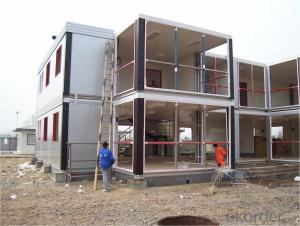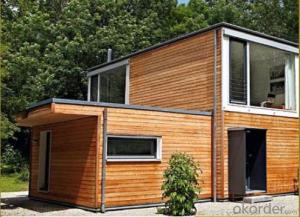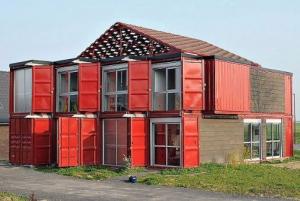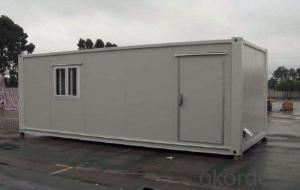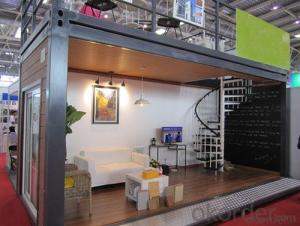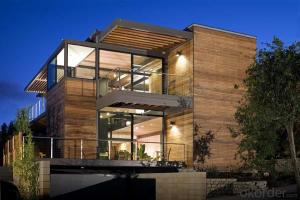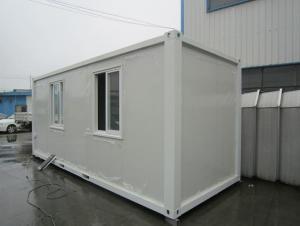Container House Flat Pack for Office with Toilet
- Loading Port:
- Tianjin
- Payment Terms:
- TT OR LC
- Min Order Qty:
- 3 set
- Supply Capability:
- 500 set/month
OKorder Service Pledge
OKorder Financial Service
You Might Also Like
Flat Pack Container House for Office with Toilet
1. The benefits of Container House
Perfect for modular/prefab site offices,cabins,warehouse,villa,toliet,shop,hotel,camp,office
Efficient, low cost designs that can be customized for end user requirements
Easy for low skilled workers to assemble
The light steel frame structure is strong and reliable
Many modular homes can be stacked and linked together to create more space
Neat inside: plumbing and wires are hidden into the sandwich panel
2. Certificates:
ISO9001, ISO14001, CSA(Canadian Standards Association), CE(European Conformity), AU(Australia Standard),UL(America standard)
FAQ:
1.How about the installation? For example, the time and cost?
To install 200sqm house needs only 45 days by 6 professional workers. The salary of enginner is USD150/day, and for workers, it's 100/day.
2.How long is the life span of the house?
Around 50 years
3. And what about the loading quantity?
One 40'container can load 140sqm of house.
The cabin can be dis-assemebled for transport.
Images:


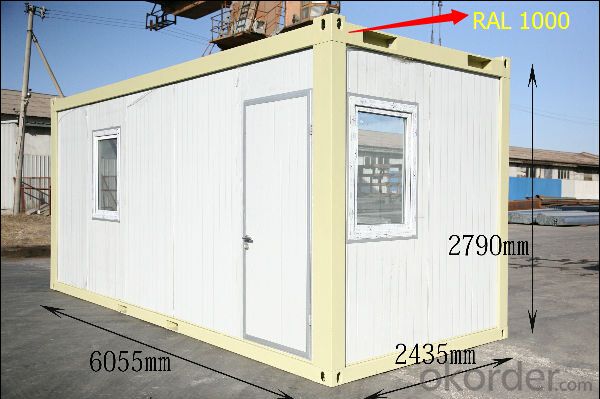
- Q:Are container houses suitable for eco-resorts or eco-villages?
- Yes, container houses are suitable for eco-resorts or eco-villages. Container houses offer several advantages that align well with the principles of eco-living. Firstly, container houses are highly sustainable as they repurpose used shipping containers that would otherwise contribute to landfill waste. By transforming these containers into habitable spaces, we reduce the demand for traditional construction materials, such as bricks and cement, which have a significant environmental impact. Secondly, container houses can be designed to be energy efficient. With proper insulation and the use of sustainable materials, these houses can minimize heat loss and reduce the need for excessive heating or cooling, thus lowering energy consumption. Additionally, container houses can be integrated with renewable energy sources like solar panels, further reducing their carbon footprint. Thirdly, container houses are modular in nature, allowing for easy expansion or relocation. This flexibility is ideal for eco-resorts or eco-villages, as they can adapt to changing needs and expand their capacity without significant disruptions to the surrounding environment. Moreover, modular construction minimizes construction waste and decreases the overall impact on the ecosystem. Finally, container houses can be designed to incorporate various eco-friendly features, such as rainwater harvesting, graywater recycling, and composting toilets. These sustainable systems help minimize water consumption and waste generation, making container houses a suitable choice for eco-resorts or eco-villages aiming to promote eco-friendly practices. In conclusion, container houses are indeed suitable for eco-resorts or eco-villages due to their sustainability, energy efficiency, modular nature, and potential for incorporating various eco-friendly features. By utilizing container houses, these environments can foster a more environmentally conscious and sustainable way of living.
- Q:Are container houses suitable for urban living?
- Depending on personal preferences and needs, container houses could be a suitable choice for urban living. Made from shipping containers, these houses are durable and easily customizable. They are compact in size, allowing them to fit into small urban spaces, which is beneficial in cities where land availability is limited. One advantage of container houses in urban areas is their sustainability. By recycling shipping containers, waste is reduced and these materials are given a second life. Furthermore, container houses can incorporate eco-friendly features such as solar panels and rainwater collection systems, making them a greener alternative to traditional housing. Compared to conventional homes, container houses are also cost-effective. The affordability and structural integrity of shipping containers make them an appealing option for those seeking affordable urban living. Additionally, the construction process for container houses is generally faster and more efficient, resulting in reduced time and labor costs. Another benefit of container houses for urban living is their mobility. These structures can be easily transported, allowing residents to relocate if necessary. This flexibility is particularly attractive to individuals who prefer a nomadic or minimalist lifestyle, or those who frequently move due to work or other reasons. However, it is important to note that container houses may not be suitable for everyone. Their limited space may not be ideal for larger families or individuals with a substantial amount of belongings. Additionally, noise and insulation could be concerns in urban areas, as container homes may not provide the same level of soundproofing as traditional houses. In conclusion, container houses offer affordability, sustainability, and mobility, making them a viable option for urban living. However, it is crucial to consider individual preferences, lifestyle, and specific urban conditions before determining if container houses are suitable for a particular person or family.
- Q:Are container houses environmentally friendly?
- Container houses can be considered environmentally friendly for several reasons. Firstly, they are constructed using repurposed shipping containers, which reduces the demand for new materials and helps to combat the problem of waste accumulation. By recycling these containers, we are able to give them a new purpose and extend their lifespan. Secondly, container houses are often designed to be energy-efficient. They can be equipped with insulation materials that help to regulate indoor temperatures, reducing the need for excessive heating or cooling. Additionally, container homes can be fitted with energy-saving appliances and solar panels, further reducing their carbon footprint. Furthermore, container houses can be designed to be self-sufficient in terms of water and energy consumption. For instance, rainwater harvesting systems can be installed to collect and reuse water for various purposes, such as irrigation or flushing toilets. This reduces the strain on local water resources. Similarly, solar panels or other renewable energy sources can provide electricity, reducing reliance on fossil fuels and reducing greenhouse gas emissions. Lastly, container houses can also contribute to the reduction of urban sprawl. By repurposing existing structures, container homes can be built in urban areas, making use of vacant lots or underutilized spaces. This can help to revitalize communities and reduce the need for new developments on previously undeveloped land, which can contribute to habitat destruction and environmental degradation. Overall, while there are certainly environmental benefits to container houses, it is important to note that their overall sustainability depends on various factors, such as the construction materials used, the energy efficiency of the design, and the location of the house. However, when designed and built with sustainability in mind, container houses can be an environmentally friendly alternative to traditional housing.
- Q:Are container houses customizable in terms of layout and size?
- Yes, container houses are highly customizable in terms of layout and size. Due to the modular nature of shipping containers, they can be easily modified to fit specific design preferences and requirements. The walls of the containers can be cut and removed to create larger spaces or to connect multiple containers together to form a larger living area. Additionally, container houses can be stacked or arranged in various configurations to suit different layouts. This level of customization allows individuals to design their container homes according to their unique needs and preferences.
- Q:Can container houses be designed with a traditional or rustic style?
- Yes, container houses can definitely be designed with a traditional or rustic style. While shipping containers are typically associated with a modern and industrial aesthetic, they can also be transformed to have a more traditional or rustic appearance. Design elements such as wooden cladding, stone veneers, or even brick facades can be added to the exterior of the container house to give it a more traditional look. These materials can help create a warm and inviting atmosphere, reminiscent of traditional homes. Additionally, the interior of the container house can be designed with rustic elements such as exposed wooden beams, reclaimed wood flooring, or vintage furniture. These features can contribute to a cozy and rustic ambiance, while still maintaining the unique and sustainable aspects of container living. Overall, with careful planning and design choices, container houses can be customized to fit any style, including traditional or rustic aesthetics.
- Q:What is the advantage of a container room?
- The use of traditional container modification, although the anti-theft effect is much better, but the insulation, noise is relatively poor, need to do interior decoration
- Q:Are container houses suitable for areas with limited access to public transportation?
- Indeed, container houses prove suitable in areas with restricted access to public transportation. Given their modular nature, they can be effortlessly transported to remote locations, rendering them a viable residential option where public transportation is scarce. Furthermore, these container houses can be designed to operate independently and off the grid, diminishing the reliance on public transportation for essential services such as electricity and water. By equipping them with solar panels and rainwater collection systems, their sustainability in regions with limited infrastructure is further augmented. Moreover, container houses can be tailor-made to meet the specific requirements of the occupants, ensuring their comfort and provision of all necessary amenities even in locales devoid of convenient public transportation. Ultimately, container houses present a flexible and pragmatic housing solution for areas with constrained access to public transportation.
- Q:Can container houses be designed to have a laundry room?
- Yes, container houses can definitely be designed to have a laundry room. While the space in a container house is limited, creative designs and efficient use of space can allow for the inclusion of a laundry room. Various options can be considered to accommodate a laundry area, such as incorporating a stackable washer and dryer unit in a designated corner, utilizing a compact combination washer and dryer, or even installing a small laundry room separate from the main living area. Additionally, clever storage solutions can be implemented to maximize the functionality of the laundry area, such as using wall-mounted cabinets or shelves for laundry supplies. With proper planning and innovative design, container houses can indeed feature a functional and convenient laundry room.
- Q:Are container houses resistant to pests and insects?
- Container houses are known for their general resistance to pests and insects. This is because they are constructed using steel or aluminum, which makes their exteriors highly durable and tough for pests to infiltrate. Furthermore, container homes have tight seals and limited openings, making it more challenging for pests and insects to enter. Nevertheless, it's crucial to acknowledge that no house is entirely immune to pests, and occasional infestations may still happen. To guarantee the ongoing pest and insect resistance of container houses, regular maintenance such as sealing cracks and monitoring for signs of pest activity is strongly advised.
- Q:Can container houses be insulated for soundproofing?
- Yes, container houses can be insulated for soundproofing. While shipping containers are made of steel, which can conduct sound easily, there are various methods to insulate them and reduce noise transmission. One common approach is to use insulation materials such as mineral wool or foam to fill the walls, ceilings, and floors of the container. This helps absorb and dampen sound vibrations, preventing them from traveling through the walls. Additionally, adding acoustic panels or soundproof curtains to the interior can further enhance sound insulation. It's important to work with professionals who have experience in soundproofing to ensure an effective and efficient insulation solution for container houses.
1. Manufacturer Overview |
|
|---|---|
| Location | |
| Year Established | |
| Annual Output Value | |
| Main Markets | |
| Company Certifications | |
2. Manufacturer Certificates |
|
|---|---|
| a) Certification Name | |
| Range | |
| Reference | |
| Validity Period | |
3. Manufacturer Capability |
|
|---|---|
| a)Trade Capacity | |
| Nearest Port | |
| Export Percentage | |
| No.of Employees in Trade Department | |
| Language Spoken: | |
| b)Factory Information | |
| Factory Size: | |
| No. of Production Lines | |
| Contract Manufacturing | |
| Product Price Range | |
Send your message to us
Container House Flat Pack for Office with Toilet
- Loading Port:
- Tianjin
- Payment Terms:
- TT OR LC
- Min Order Qty:
- 3 set
- Supply Capability:
- 500 set/month
OKorder Service Pledge
OKorder Financial Service
Similar products
New products
Hot products
Related keywords
